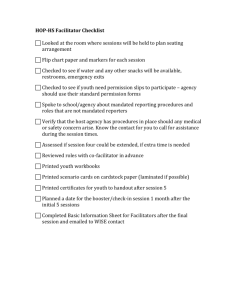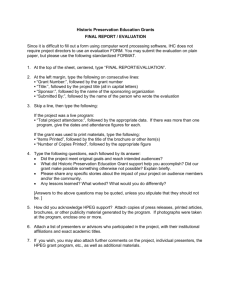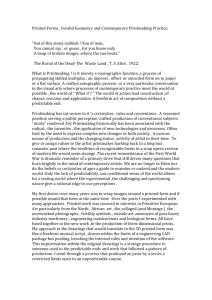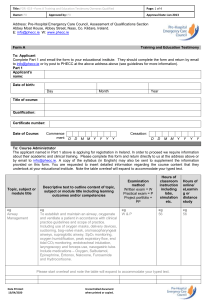South Carolina Department of Archives and History
advertisement
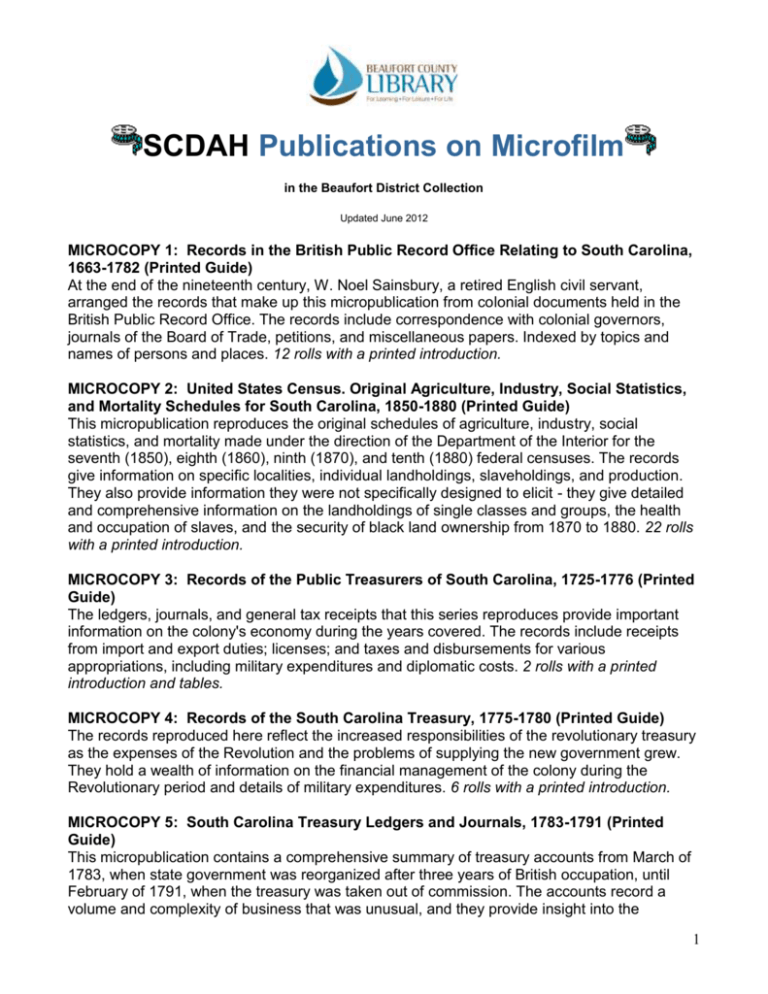
SCDAH Publications on Microfilm in the Beaufort District Collection Updated June 2012 MICROCOPY 1: Records in the British Public Record Office Relating to South Carolina, 1663-1782 (Printed Guide) At the end of the nineteenth century, W. Noel Sainsbury, a retired English civil servant, arranged the records that make up this micropublication from colonial documents held in the British Public Record Office. The records include correspondence with colonial governors, journals of the Board of Trade, petitions, and miscellaneous papers. Indexed by topics and names of persons and places. 12 rolls with a printed introduction. MICROCOPY 2: United States Census. Original Agriculture, Industry, Social Statistics, and Mortality Schedules for South Carolina, 1850-1880 (Printed Guide) This micropublication reproduces the original schedules of agriculture, industry, social statistics, and mortality made under the direction of the Department of the Interior for the seventh (1850), eighth (1860), ninth (1870), and tenth (1880) federal censuses. The records give information on specific localities, individual landholdings, slaveholdings, and production. They also provide information they were not specifically designed to elicit - they give detailed and comprehensive information on the landholdings of single classes and groups, the health and occupation of slaves, and the security of black land ownership from 1870 to 1880. 22 rolls with a printed introduction. MICROCOPY 3: Records of the Public Treasurers of South Carolina, 1725-1776 (Printed Guide) The ledgers, journals, and general tax receipts that this series reproduces provide important information on the colony's economy during the years covered. The records include receipts from import and export duties; licenses; and taxes and disbursements for various appropriations, including military expenditures and diplomatic costs. 2 rolls with a printed introduction and tables. MICROCOPY 4: Records of the South Carolina Treasury, 1775-1780 (Printed Guide) The records reproduced here reflect the increased responsibilities of the revolutionary treasury as the expenses of the Revolution and the problems of supplying the new government grew. They hold a wealth of information on the financial management of the colony during the Revolutionary period and details of military expenditures. 6 rolls with a printed introduction. MICROCOPY 5: South Carolina Treasury Ledgers and Journals, 1783-1791 (Printed Guide) This micropublication contains a comprehensive summary of treasury accounts from March of 1783, when state government was reorganized after three years of British occupation, until February of 1791, when the treasury was taken out of commission. The accounts record a volume and complexity of business that was unusual, and they provide insight into the 1 difficulties faced by the treasurers, who had to struggle with the claims of close to ten thousand people who had supported the Revolution, with the thousands of indented notes of credit the government had issued, and with the sale of forfeited Loyalist estates. 4 rolls with a printed introduction and index. MICROCOPY 6: Duties on Trade at Charleston, 1784-1789 (Printed Guide) The only records of their kind in South Carolina, the seven surviving books that make up this series record every entry of goods into Charleston during the period covered. The records detail the type and quantity of goods imported, show South Carolina's reliance on Great Britain for most of its basic supplies, give information on the number of slaves imported, and are a fine guide to the careers of individual merchants. 1 roll with a printed introduction and tables. MICROCOPY 7: South Carolina Treasury Ledgers and Journals, 1791-1865 (Printed Guide) This micropublication reproduces treasury ledgers and journals that reflect several reorganizations of the treasury. Some are detailed, others less so. The journal of the lower division from 1791 to 1802 is extraordinarily useful. It lists the indents issued after 1792 for claims growing out of the Revolution, records the settlement of bonds and notes for duties incurred between 1783 and 1789, and accounts for receipts from tardy tax collectors. The remaining books serve as a general guide to the finances of the period. 12 rolls with a printed introduction. MICROCOPY 8: Accounts Audited Growing Out of the Revolution in South Carolina (Printed Guide) Indexed also on “Online Records Index” found at http://www.archivesindex.sc.gov After the collapse of state government following the occupation of Charleston by the British in 1780, South Carolina financed its war effort by issuing vouchers - receipts that were often no more than a few hastily scribbled lines - for supplies furnished or military service rendered. The more than ten thousand files that make up this series hold the receipts that individuals presented to the treasury to support their claims, and they often include auditor's papers, interest-bearing certificates called principal indents, and treasury and legislative papers that were related to the claims. Some files provide only brief descriptions of military service; others give considerable detail. The series offers insights into South Carolina's Revolutionary War debt and into the way in which the American Revolution affected the lives of the state's inhabitants. Indexed. 165 rolls with a printed introduction. MICROCOPY 9: South Carolina Will Transcripts, 1782-1868 (Printed Guide) Indexed also on “Online Records Index” found at http://www.archivesindex.sc.gov This micropublication reproduces Civil Works Administration transcripts of surviving pre-Civil War wills of twenty-one counties: Abbeville, Anderson, Barnwell, Chester, Darlington, Edgefield, Fairfield, Greenville, Horry, Kershaw, Laurens, Marion, Marlboro, Newberry, Pickens, Richland, Spartanburg, Sumter, Union, Williamsburg, and York. Although twice or three times removed from the original wills, the transcripts in this series are important. Used as a consolidated set in conjunction with the Charleston will transcripts, they have long provided the most expeditious route to the contents of antebellum South Carolina wills. And in some cases, they reproduce information no longer extant in damaged originals. Indexed. 31 rolls with a printed introduction. MICROCOPY 10: South Carolina State Plats, Charleston Series, 1784-1860; Columbia Series, 1796-1868 (Printed Guide) Indexed also on “Online Records Index” found at http://www.archivesindex.sc.gov 2 South Carolina created the state plats as part of its process for granting vacant public lands. This series reproduces scale drawings of tracts, names of surrounding land holders, and natural and man-made geographic features of the S.C. landscape. The series is an essential source for genealogy and local history and has rich potential for social, cultural, and economic history. 30 rolls with a printed introduction; 13-roll COM index. MICROCOPY 11: State Free Negro Capitation Tax Books, Charleston, South Carolina, ca. 1811-1860 (Printed Guide) The twenty-nine books in this publication list names of many free blacks who lived in Charleston between 1811 and 1860. The tax collector of the parishes of St. Philip's and St. Michael's probably created the books to collect the capitation tax between 1756 and 1865. Names, addresses, tax status, and notations like 'dead' and 'overage' appear. The 1822 and 1823 books list occupations. 2 rolls with a printed introduction. MICROCOPY 12: Memorials of 17th and 18th Century South Carolina Land Titles (Printed Guide) Indexed also on “Online Records Index” found at http://www.archivesindex.sc.gov The fourteen volumes in this series are nineteenth century copies of memorials (abstracts) of land titles that were recorded between 1731 and 1775 by the office of His Majesty's Auditor General for South Carolina. The memorials were created to help with the collection of the quitrent, an annual payment made by the landholder. Although the series never evolved into a complete record of all holdings subject to quitrent, it is still an extremely important research resource. It provides the only surviving record of some transactions, and it contains proprietary land grants, certificates of admeasurements, wills, leases, releases, and other documents. Computer output microfilm index. 7 rolls with a printed introduction; 5-roll COM index. MICROCOPY 13: South Carolina Reports and Resolutions, 1868-1900: With a Finding Aid to Reports and Resolutions, 1784-1900 (Printed Guide) Roll 1 of this micropublication reproduces a descriptive finding aid to the series and gives a brief history of the state's agencies and officials. The series itself includes reports and resolutions generated by the legislature during regular and special sessions, annual reports of various state agencies and officials, and special reports submitted to legislative committees. Indexed. 30 rolls with a printed introduction. MICROCOPY 14: Journal of the South Carolina Court of General Sessions, 1769-1776 (Printed Guide) The Court of General Sessions of this period dispensed justice and administered the law in criminal cases to the white population in South Carolina. The journal reproduced here includes proceedings of twenty-three court sessions, and it also documents South Carolina's transition from a statewide court system to a circuit court system. Its pages contain brief descriptions of crimes brought to trial, give the names of the accused and sometimes of an accuser or victim, and illustrate conviction and sentencing patterns. They also give names of presiding judges, defense attorneys, and jurors, and they hold presentments submitted by grand juries. Computer output indexed. 1 roll with a printed introduction; 1-roll COM index. MICROCOPY 15: South Carolina Tax Returns, 1783-1800 (Printed Guide) Most of the records filmed for this publication are the general returns compiled by the tax collectors. They are important because of all the tax records produced before 1808, only the few filmed for this publication and two others are known to have survived. They are also important because they supply information on land owners and the size of holdings that contemporary census records and deed books do not. The returns name tax collectors and 3 taxpayers and show commodities being taxed, rates of taxation, and amounts paid. Other records filmed are closely related to the returns - collectors' certificates, registers of property, and so forth. 2 rolls with a printed introduction, which includes a finding aid to collection districts and three maps of the tax districts. MICROCOPY 16: Records of the Confederate Historian (Printed Guide) This micropublication holds five volumes of records. Roll 1: the Roll of Honor, memorializing South Carolina's dead soldiers; Roll 2: the Roll of Dead South Carolina troops and the Roll of South Carolina Volunteers in the Confederate States Provisional Army; Roll 3: Vol. 1 - Field and Staff Officers; Roll 4: Vols. 2 & 3 - Infantry; Roll 5: Vol. 4 - Cavalry and Artillery; and Roll 6: Vol. 5 - Miscellaneous and State Troops. 6 rolls with printed introduction. MICROCOPY 17: Petitions to the General Assembly Indexed on “Online Records Index” found at http://www.archivesindex.sc.gov Legislative petitions generally take the form of written requests from state citizens submitted to the General Assembly, requesting that the Assembly use its authority to redress a particular wrong from 1776-1883. This series is indispensable in showing how the General Assembly thought and worked in this period. Responding to petitions allowed the legislature to exercise power that affected the whole state and sometimes reached directly into individual lives. In this category, some of the matters they regularly considered were: divorce (which only they could grant), freedom for an owner's slaves, the amount of education a slave could receive, proper observance of the Sabbath, and citizens' upkeep of the roads near their residences. More comprehensive and wider subjects of petitions include the legal system; penal system; legislative system; slavery; internal improvements; inland navigation; religion; incorporation of churches, societies, and companies; military matters; elections; education; foreign affairs; Indian affairs; relations with other states; state finance; and banking. 109 rolls MICROCOPY 18: Judgment Rolls, Court of Common Pleas, 1703-1790 Indexed on “Online Records Index” found at http://www.archivesindex.sc.gov This series comprises the original papers of record in each civil suit in which judgment is signed. All papers pertaining to a particular case are filed together in one bundle or "roll." The early rolls contain the plaintiff's complaint and the court's judgment. Later authentication of the complaint (the bond signed by the defendant or an account) was added to the roll. Judgment rolls of the last half of the eighteenth century usually contain the complaint and supporting documents, such as the writ of attachment, verification of execution, defendant's reply, and the court's judgment. Arbitrated cases contain the auditor's name and the commission to settle the amount due. Information consists of the names of the plaintiffs, defendants, and attorneys; the nature of the suit; and the final judgment. Documentation of indebtedness entered into cases sometimes contains considerable data on purchases and other information valuable for social history. 148 rolls 4
